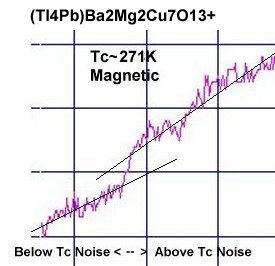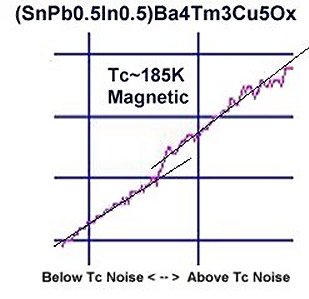

After 25 years of intense research, the mechanism by which high temperature superconductivity occurs is still a mystery. Many scientists believe that vibrations within the crystal lattice - which are known to enable low temperature superconductivity - must also play a role in HT superconductivity. And, although recent research1 questions the contribution lattice vibrations make to high temperature superconductivity, new support for phonons now comes from an unlikely source: the RMS noise figures of recently-discovered HT superconductors.
Among superconductors with Tc's above 180K all display a low signal-to-noise
ratio (S/N) due to a small volume fraction. This noisy environment is a disadvantage when trying to determine the resistive
or magnetic Tc of a minority phase. But, it has proven serendipitous when trying to gauge the relationship between lattice
vibrations and high temperature superconductivity.


As can be seen in all of the sample plots on this page, there is an unmistakable drop in the noise level below Tc in every material. (A line has been drawn through the noise to illustrate the AC component of the noise.) Thermal noise is inherent to all electronic circuits and can only be suppressed by cooling the circuit. However, what we see in each of these plots is not a gradual drop in noise as the temperature goes lower, but a sudden drop in noise below Tc. This is the "smoking gun" that points to a link between lattice vibrations and HT superconductivity.
Surprisingly, the noise attenuation appears to be in the 1 to 3 db range, which is far greater than the volume fraction of the superconductive phase, which is less than 1% of the bulk. This suggests the link is quite strong.


Conclusion: Since background noise arises from lattice vibrations, a drop in the noise level when superconductivity is established is the first direct evidence that lattice vibrations are intertwined with the superconductivity process. To read more on this, click HERE.
E. Joe Eck
© 2011 Superconductors.ORG
All rights reserved.
(1) http://physicsworld.com/cws/article/news/33889
 BACK to "News" page at Superconductors.ORG
BACK to "News" page at Superconductors.ORG